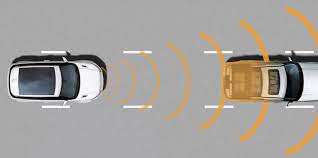
The device and principle of operation of the adaptive cruise control
Content
Constantly keeping your foot on the gas pedal is quite uncomfortable during long trips. And if earlier it was impossible to maintain the speed of movement without pressing the pedal, then with the development of technology, it was possible to solve this problem as well. Adaptive cruise control (ACC), found in many modern cars, is able to maintain a constant speed even when the driver's foot is removed from the accelerator.
What is adaptive cruise control
In the automotive industry, the cruise control system was applied in the middle of the twentieth century, when in 1958 Chrysler introduced the world to the first cruise control created for vehicles. A few years later - in 1965 - the principle of the system was revised by American Motors, which created a mechanism that is closest to the modern one.
Adaptive Cruise Control (ASS) has become an improved version of the classic cruise control. While a conventional system can only automatically maintain a given vehicle speed, then adaptive cruise control is able to make decisions based on traffic data. For example, the system can reduce the vehicle speed if there is a hypothetical collision hazard with the vehicle in front.
The creation of ACC is considered by many to be the first step towards full automation of vehicles, which in the future can do without driver intervention.
Elements of the system
The modern ACC system includes three main components:
- Touch sensors that determine the distance to the vehicle in front, as well as its speed. The range of the sensors is from 40 to 200 meters, however, devices with other ranges can be used. The sensors are mounted on the front of the vehicle (for example, on the bumper or radiator grille) and can work according to the principle:
- a radar that emits ultrasonic or electromagnetic waves;
- lidar based on infrared radiation.
- Control unit (processor) that reads information from sensors and other vehicle systems. The received data is checked against the parameters set by the driver. The tasks of the processor include:
- determining the distance to the vehicle in front;
- calculating its speed;
- analysis of the information received and comparison of indicators with the speed of your vehicle;
- comparison of the driving speed with the parameters set by the driver;
- calculation of further actions (acceleration or deceleration).
- Equipment that sends a signal to other vehicle systems - stability control system, automatic transmission, brakes, etc. All of them are associated with the control module.
System control principle
The activation and deactivation of adaptive cruise control is controlled by the driver and is carried out using a control panel, which is most often installed on the steering wheel.
- You can turn the system on and off using the On and Off buttons, respectively. If they are missing, the Set button is used as a replacement to activate the cruise control. The system is deactivated by pressing the brake or clutch pedal.
- Parameters can be set using the Set button. After pressing, the system fixes the actual speed and continues to maintain it while driving. Using the "+" or "-" keys, the driver can increase or decrease the speed by a predetermined value with each press.
Adaptive cruise control starts to operate at a speed of at least 30 km / h. Uninterrupted operation is possible when driving no more than 180 km / h. However, some models of the premium segment are capable of working from the moment they start driving and up to a speed of 200 km / h.
In which cars is ACC installed
Car manufacturers care about the maximum comfort of the driver and passengers. Therefore, most car brands have developed their own variations of the ACC system. For example, in Mercedes cars, the adaptive cruise control system is called Distronic Plus, in Toyota - Radar Cruise Control. Volkswagen, Honda and Audi use the name Adaptive Cruise Control. However, regardless of the variants of the name of the mechanism, the principle of its operation in all cases remains the same.
Today, the ACC system can be found not only in premium segment cars, but also in improved equipment for mid and budget cars, such as Ford Focus, Huyndai Solaris, Renault Duster, Mazda3, Opel Astra and others.
Advantages and disadvantages
The use of the adaptive cruise control system has not only obvious advantages, but also some disadvantages. The advantages of ACC include:
- increasing the level of safety of the driver and passengers (the system helps to avoid accidents and collisions with the vehicle in front);
- reducing the load for the driver (a motorist who is tired during a long trip will be able to entrust the speed control to the automatic system);
- fuel economy (automatic speed control does not require unnecessary pressing on the brake pedal).
Disadvantages of adaptive cruise control include:
- psychological factor (the operation of the automatic system can relax the driver, as a result of which objective control over the traffic situation will decrease);
- the possibility of technical malfunctions (no mechanism can be completely protected from malfunctions in operation, therefore, you should not completely trust the automation).
It is important for the motorist to take into account that in the conditions of rain or snowfall, the sensors on some devices may malfunction. Therefore, the driver must monitor the traffic situation in order to react in time to a possible emergency.
Adaptive cruise control will be an excellent assistant on a long journey and will allow the driver to rest a little, entrusting the car with speed control. However, it is necessary to understand that it is unacceptable to completely lose control of the traffic situation: even the most reliable equipment can fail, so it is important for the driver to be ready at any time to take control of the vehicle completely into his own hands.

